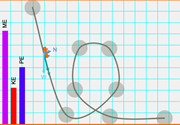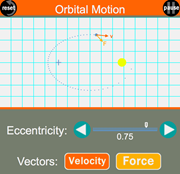 Roller Coaster Model
Roller Coaster Model
Up. Down. Spin around. Amidst all the rising, falling and turning of a roller coaster ride is heaps of physics. The Roller Coaster Model allows a learner to explore some of this physics. Whether it is the first drop, a loop, or a collection of dips and hills, you will be able to study it all with this Interactive. Use three pre-designed tracks or design your own. Let the car roll and watch as energy changes form and force, acceleration, and velocity vectors change their size and direction. Explore on your own or use The Physics Classroom's ready-to-use exercise.
 Orbital Motion
Orbital Motion
Everyone knows that the planets orbit the Sun in a circular orbit, right? Well ... not exactly. A 17th century mathematician by the name of Johannes Kepler was able to show that the orbits of planets about the sun are elliptical in shape. In this Interactive, learners will investigate the nature of an elliptical orbit.